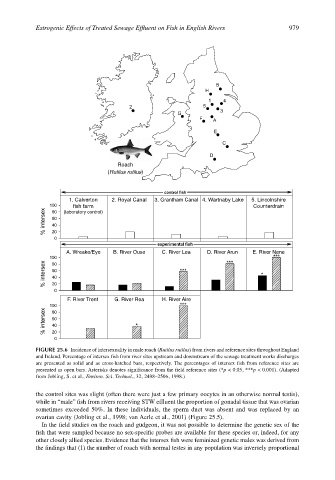Page 999 - The Toxicology of Fishes
P. 999
Estrogenic Effects of Treated Sewage Effluent on Fish in English Rivers 979
Roach
(Rutilus rutilus)
1. Calverton 2. Royal Canal 3. Grantham Canal 4. Wartnaby Lake 5. Lincolnshire
fish farm Counterdrain
(laboratory control)
A. Wreake/Eye B. River Ouse C. River Lea D. River Arun E. River Nene
F. River Trent G. River Rea H. River Aire
FIGURE 25.6 Incidence of intersexuality in male roach (Rutilus rutilus) from rivers and reference sites throughout England
and Ireland. Percentage of intersex fish from river sites upstream and downstream of the sewage treatment works discharges
are presented as solid and as cross-hatched bars, respectively. The percentages of intersex fish from reference sites are
presented as open bars. Asterisks denotes significance from the field reference sites (*p < 0.05, ***p < 0.001). (Adapted
from Jobling, S. et al., Environ. Sci. Technol., 32, 2498–2506, 1998.)
the control sites was slight (often there were just a few primary oocytes in an otherwise normal testis),
while in “male” fish from rivers receiving STW effluent the proportion of gonadal tissue that was ovarian
sometimes exceeded 50%. In these individuals, the sperm duct was absent and was replaced by an
ovarian cavity (Jobling et al., 1998; van Aerle et al., 2001) (Figure 25.5).
In the field studies on the roach and gudgeon, it was not possible to determine the genetic sex of the
fish that were sampled because no sex-specific probes are available for these species or, indeed, for any
other closely allied species. Evidence that the intersex fish were feminized genetic males was derived from
the findings that (1) the number of roach with normal testes in any population was inversely proportional

